Skin disease caused by tuberculous mycobacteria - tuberculosis. Another name for the pathogen is Koch's wand. Pathology has a long and severe course, there are often relapses. There are various forms of the disease that have their own symptoms. Therefore, it is necessary to study the photographs in order to know exactly what the pathology looks like. Skin tuberculosis occurs in adults and children.
Mycobacterium was discovered in 1882 by Robert Koch. The causative agent of the disease multiplies during the day through division and budding. Mycobacterium causes tuberculosis of the lungs, skin and bones. When compared with the defeat of the respiratory system, the pathology of the integument is less common.
Koch's stick is resistant to frost, lasts up to 15 minutes. in hot water. In a dried state, the pathogen can live for 3-4 years. In wastewater, the stick exists for up to 12 months, in manure - 15 years.
Mycobacterium tuberculosis (MBT) has a high sensitivity. Therefore, even disinfection does not provide quick positive dynamics in getting rid of Koch's bacillus.
Factors that can destroy mycobacterium:
- ultraviolet - the time of death of the stick varies from 2 to 3 minutes;
- rays of the sun - from 60 to 90 minutes;
- boiling water - 15 minutes;
- disinfection with chlorine - 5 hours.
Koch's wand is subdivided into human, bovine and avian. The first variety is most common. Bovine bacillus occurs in 25% of cases. The bird species is very rare in humans.
Record content:
- 1 Views
- 2 Stages and degrees
- 3 Symptoms
- 4 Reasons for the appearance
- 5 Diagnostics
- 6 When to see a doctor
- 7 Prophylaxis
-
8 Treatment methods
- 8.1 Medications
- 8.2 Traditional methods
- 8.3 Other methods
- 9 Possible complications
- 10 Tuberculosis Videos
Views
Skin tuberculosis (symptoms in adults, a photo of the cover allows you to make a correct diagnosis) is a pathology that has a classification.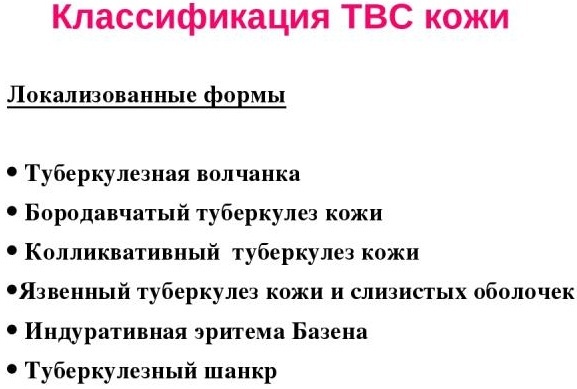
Varieties of the disease:
- localized (focal) - a single lesion of the skin;
- disseminated - in another way, tuberculosis is called common, characterized by damage to a significant part of the skin.
Each variety has its own characteristics.
Stages and degrees
Cutaneous tuberculosis is classified into the following grades:
- primary - the degree encountered in people who have not previously been infected with tuberculosis;
- secondary - this diagnosis is given to people who have had tuberculosis.
Symptoms
Skin tuberculosis has certain characteristics, depending on the classification.
Localized tuberculosis of the cover is subdivided into types. Each of them has its own symptoms. The signs are listed in the table.
| Name of tuberculosis | Description |
| Tuberculous lupus | Another name is lupoid type. This form is the most common, occurs in 75% of cases. Pathology is often diagnosed in children. The course of the disease is allowed up to 10 years, with remissions (remission of symptoms). Lupus can be associated with internal tuberculosis. According to statistics, together with a lesion of the skin, Koch's bacillus is localized in the lungs in 10% of cases, in bones and joints in 20% of cases. Possible stages of the disease:
2. Uneven plaques that appear due to fusion and enlargement of the subcutaneous tubercles. An ulcer is located in the center of the rash. 3. The formation of flat scars on the integument, indicating healing. The symptom occurs after 1 - 1.5 months. from the onset of pathology. Signs of lupus:
|
| Warty | This type is most often found in children and men. Localization - bones and fingers, less often on the legs. Signs that indicate the disease: 1. Nodules. The lesions are bluish in color and small in size (up to 1 cm in diameter). The nodules are dense, tenderness appears on palpation. Additionally, the clear boundaries of the formations are noted. The bumps can grow and merge with each other. Most often, warty tuberculosis manifests itself on the extremities - feet, hands, legs. 2. Flat plaques. Formed after nodules, have layers. On the formations, necrosis (death) of tissues is manifested. Additionally, the appearance of a crust, cracks, flakes is possible. 3. Discharge of pus from formations when pressed on the skin. 4. Scarring. 5. Swollen lymph nodes. Usually, the general well-being of a person does not change, it remains satisfactory. |
| Collicative | Another name is scrofulodermal tuberculosis. In terms of prevalence, the form is in 2nd place after lupus. It occurs in childhood and adolescence. Formations are localized on the elbows, clavicle, ears. Additionally, the rash is located on the face, armpits. The scrofulodermal form often occurs with pulmonary or bone tuberculosis. Combination with other skin lesions is allowed - lupus, warty variety. Symptoms of the disease:
|
| Ulcerative | The species appears as a complication of pulmonary tuberculosis.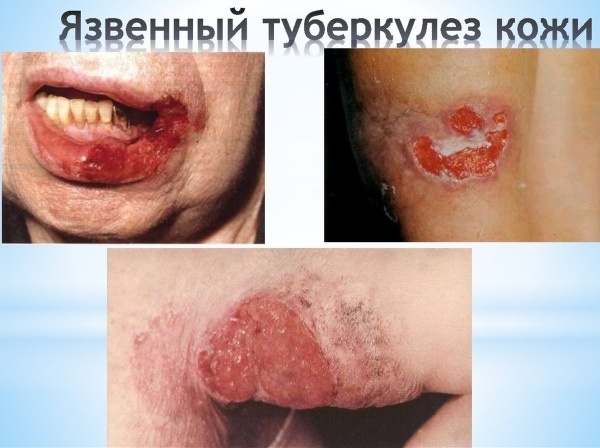 Rash stages:
2. The transformation of the tubercles into purulent yellowish vesicles. 3. Ulceration with raised edges and a reddish bottom, which is covered with plaque. At the bottom and near the rash there are yellow nodules with cheesy degeneration (Treel grains). Symptoms include soreness of the skin, difficulty opening the mouth. If ulcers form in the anus or urethra, pain during urination and bowel movements is acceptable. Additionally, signs of pneumonia may appear - coughing up blood, coughing, excessive sweating. The appearance of ulcers on the integument and mucous membranes is allowed. |
| Inductive | Another name is compacted tuberculosis or Bazin's erythema. It often occurs in women. The nodes appear in the subcutaneous fat, do not have clear boundaries. Soreness may occur on palpation. Further development of the nodes:
Formations are localized on the legs, arms, buttocks. The appearance of nodes on the thighs or mucous membrane is allowed (rarely). When the disease begins, the color of the skin does not change. Then the cover turns brownish or purple-red. With inductive tuberculosis, relapses occur in winter or autumn, the pathology can last for several years. Sometimes the disease is accompanied by inflammation of the lymph nodes. |
Disseminated tuberculosis has varieties with specific features. Symptoms are listed in the table.
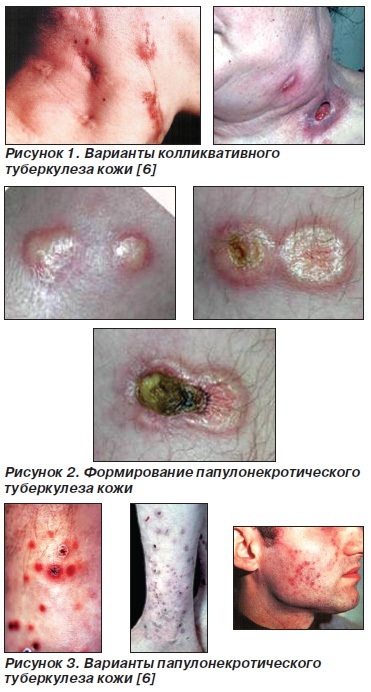
| Skin tuberculosis name | Description |
| Papulonecrotic | The disease often appears in adulthood, and especially in girls 15 - 25 years old. And also the variety is found in children. With a disease, the inner lining of small vessels becomes inflamed due to the penetration of Koch's bacillus into the body - this is an immune response. MBT enter the body of a person who already has tuberculosis. That is, from the internal organs. Papulonecrotic tuberculosis can be combined with an indurative or collicative type. The form is characterized by an acne-like rash. Formations are dense, with multiple or crowded nodules. The rash is pinkish, reddish, or brownish purple in color. After 1 - 2 months. the center of the nodule dies off, a dense dark brown crust forms. When the latter is rejected, a reddish and deep scarring without pigmentation appears. The rash can be localized on the face and buttocks. Additionally, the extensor surfaces of the limbs and ears are affected. Due to the likelihood of relapse in autumn and spring, the elements can develop differently in one area of the skin. |
| Lichenoid | Another name is scrofulous lichen. The disease can develop in any age group. But most often it appears in children with reduced hemoglobin and people with tuberculous lesions of internal organs. Symptoms of the lichenoid variety:
Formations affect the entire body. Rashes are localized on the scalp, face, chest. Additionally, nodules can be on the lower back, buttocks, and thighs. |
| Billion | The rash is profuse, has a red-blue or red-brown tint. There are crusts on the tops of the papules. After the rash disappears, scars remain. |
Reasons for the appearance
Skin tuberculosis in adults and children (photos of the cover and symptoms are important for diagnosis) is a disease that can occur for various reasons. Normally, Koch's bacillus must be destroyed by immune cells.
But it is possible to develop skin tuberculosis in the following cases:
- the protective functions of the body are weakened;
- the causative agent of the disease has been in contact with the body for a long time.
There are factors that increase the likelihood of getting the disease.
These include the following items:
- improper nutrition;
- abuse of bad habits;
- neglect of personal hygiene;
- living in places with unfavorable ecology;
- special climatic conditions - constant dampness or heat;
- endocrine disorders;
- diseases of the nervous system;
- violation of water metabolism;
- high probability of respiratory diseases;
- chronic infections or inflammations;
- diabetes;
- long-term and uncontrolled use of drugs;
- vitamin deficiency - lack of vitamins;
- frequent stressful situations;
- changes in hormonal levels - pregnancy, adolescence, menopause.
The combination of several risk factors increases the likelihood of a decrease in immunity and the appearance of pathology.
Infection with the disease is possible in the following ways:
- Endogenous. There is tuberculosis in the body. For example, in the lungs or bones. The virus can be transmitted through the blood (hematogenous) or lymphatic vessels (lymphogenous variety) from the site of inflammation. Rarely, Koch's bacillus is introduced into the skin from the lymph nodes. The transmission method is common.
- Exogenous. It is characterized by the penetration of Koch's wand into the skin of a healthy person through damage to the skin (abrasions, wounds). Pathology is transmitted from the infected. And it is also possible to penetrate Koch's sticks when the skin of a healthy person comes into contact with affected objects. Additionally, infection from sick animals cannot be ruled out. For example, when working on a farm or abattoir.
Diagnostics
Tuberculosis of the skin (symptoms in adults, photos of the cover are necessary for the appointment of a diagnosis) is a disease that needs to be examined. The methods are shown in the table.
| Name | Description |
| Mantoux test | The Mantoux reaction allows you to determine the presence of tuberculosis in the body. The procedure has nothing to do with vaccination. Many people mistakenly call the test a vaccine. The confusion is due to the fact that in both cases, a drug enters the top layer of the skin, which forms a lump. Often the analysis is performed in kindergartens and schools to determine the health status. The Mantoux test includes an extract from mycobacteria. The analysis must be carried out every year in order to detect the infection in time. The nurse measures the bump with a ruler to interpret the result. Moreover, not the entire place of redness is taken into account, but only the tubercle. Measurement takes place 2 to 3 days after drug administration. Possible sample results:
The trace from the Mantoux test disappears after 7 - 10 days from the beginning of the conduct. But it is necessary to exclude the effect on the skin. That is, do not comb or cover the cover with a plaster. |
| Determination of mycobacterium tuberculosis DNA | Laboratory analysis is carried out by the method of polymerase chain reaction (PCR). Due to its high sensitivity, it is possible to determine the DNA fragments of tuberculosis. For the analysis, it is allowed to submit any biomaterial. For example, urine, blood, cerebrospinal fluid. Analysis results will be ready in 1 - 3 days. |
| Immuno-diagnosis of tuberculosis infection | The study can be used as an alternative to the Mantoux test. Testing is carried out outside the human body. That is, in laboratory conditions, the biomaterial is mixed with mycobacterium tuberculosis. The disease is judged by the appearance of T cells that respond to Koch's bacillus. If there is no infection, then there are no T cells. Human blood is used for analysis. It is collected in a test tube with lithium heparin. The substance is applied to the walls. Heparin is an anticoagulant, meaning it prevents blood from clotting, but does not distort the test. Analysis results will be ready in 4 days. Among the minuses, the high cost is noted - more than 7,000 rubles. And also the analysis can be done not in all organizations. |
| X-rays of light | The procedure is used to detect pulmonary tuberculosis. To perform an X-ray, a person stands in front of the apparatus or enters a booth. The medical professional takes a picture. |
| Bacteriological culture from the skin | The material for research can be the contents of the rashes. In the course of inoculation, strains of microorganisms are detected and identified. |
| Lymph node puncture | Analysis involves taking a biomaterial with an instrument and transferring it to a laboratory to study the components. With the help of a puncture, it is possible to identify tuberculosis. |
The cost of diagnostics is different. It all depends on the list of procedures, city, organization. Therefore, the price must be found out in a specific clinic.
Free diagnostics are allowed. To do this, you should visit the clinic, taking with you a compulsory health insurance policy (OMS).
When to see a doctor
In case of skin tuberculosis, see a doctor. The disease is in the competence of the dermatologist.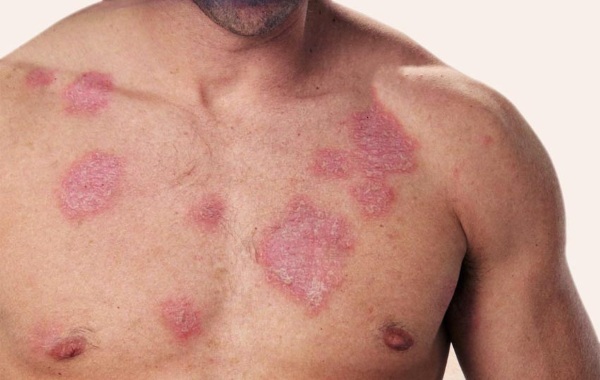
The doctor performs the following actions:
- interviews the patient - the item allows the doctor to identify the symptoms of the disease;
- takes into account concomitant diseases and the influence of factors - it is possible to identify previously transferred tuberculosis of the lungs or bones, the presence of provoking points (malnutrition and others);
- examines the patient - the doctor measures human health indicators (pulse, blood pressure, temperature), pays attention to the condition of the skin, additionally listens to the lungs and heart.
Next, an examination is prescribed to clarify the diagnosis.
If it is impossible to visit a dermatologist, it is allowed to contact a therapist. This is a general practitioner who will write a referral to the correct specialist (if required). The need for consultation depends on the cause of the onset of the disease. For example, if you have pulmonary tuberculosis, you need to visit a pulmonologist.
Prophylaxis
Skin tuberculosis is a disease that can be reduced.
To do this, you must adhere to the following rules:
- strengthen the immune system - walk more in the fresh air, play sports, take vitamin complexes;
- Healthy food;
- eliminate bad habits;
- follow the rules for caring for personal hygiene;
- choose places for living with a favorable ecology and optimal climatic conditions (without constant heat and dampness);
- exclude long-term and uncontrolled use of drugs;
- treat diseases in a timely manner;
- eliminate stress;
- make a vaccine against tuberculosis - vaccination is mandatory for newborns;
- adhere to safety precautions if professional activities involve contact with infected animals;
- undergo a preventive examination once every 6 months;
- undergo a complete examination of the body 1 time in 12 months;
- consult a doctor in a timely manner if you suspect tuberculosis.
Treatment methods
Skin tuberculosis (symptoms in adults, photos of rashes are important when making a diagnosis) is a pathology that needs to be treated. Medicines, herbal recipes and other methods are used as therapy.
In the first few months, it is better to be in a hospital. Doctors will track the body's response to the prescribed therapy and recommend further treatment.
For prevention, you should undergo a medical examination 2 times a year. After the end of tuberculosis therapy, a person is registered for another 5 years. Withdrawal is possible only after the expiration of the period, as well as with a negative result of the disease test.
Medications
Medicines can eliminate negative symptoms and alleviate a person's well-being. Frequently prescribed drugs are listed in the table.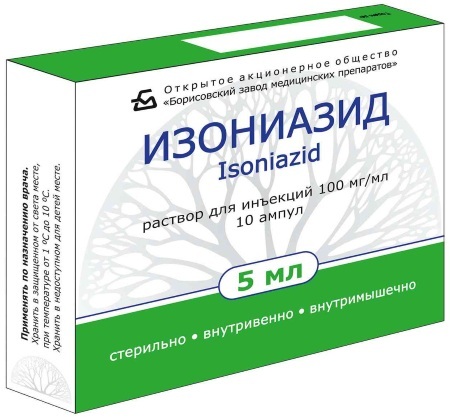
| Group of drugs | Action | List of funds |
| Anti-tuberculosis | The drugs treat tuberculosis. Since the therapy is long and can reach 6 - 8 months, the simultaneous appointment of several drugs is allowed. That is, first, 2 funds of this group are prescribed, then the combination is changed from time to time. The therapy regimen is due to the fact that Koch's wand adapts to the medication. There are 2 rows of tools. If the 1st row is ineffective, a medication from the 2nd is prescribed. | Isoniazid (1 row), Kanamycin (2 row), Rifampicin (1 row) |
| Hepatoprotectors | The drugs restore the structure of the liver and protect the organ from the effects of adverse factors. A group of medicines is prescribed due to the use of anti-tuberculosis drugs. | Geptral, Phosphogliv, Essentiale Forte N |
| Vitamin complexes | Means restore the lack of vitamins and minerals. | Vitrum, Complivit, Alphabet |
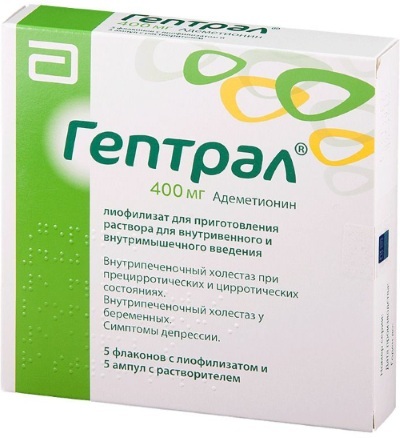
Medication must be prescribed by a specialist. The doctor studies the information specified in the instructions for use of each drug and decides on the appointment of the drug.
Traditional methods
Herbal recipes have a low likelihood of side effects due to their natural composition. It is better to use alternative therapy in combination with other methods of treatment. Compliance with the rule will speed up recovery.
For tuberculosis of the skin, you can use the following recipes:
- Marshmallow root. For cooking, you need to take 100 g of fresh plant root and 1 glass of sour cream. The dairy product can be replaced with cream. Moisten a cotton cloth in a gruel and apply to the affected skin, keep it overnight. To enhance the effect, you can put a plastic bag on the compress, and a towel on top.
At the same time, it is necessary to take an infusion of marshmallow with milk. For cooking, you should take 2 tablespoons. chopped plant root and 1 glass of hot milk (50 - 60 degrees). Insist 4 hours, drink the amount for 3 - 4 doses. It is better to take the infusion warm.
- Ointment. To prepare the recipe, you need to take the immortelle, mountain arnica and calendula - 1 part of each component. Additionally, you will need unsalted butter or pharmacy petroleum jelly - 4 parts. Mix everything thoroughly, apply to the affected skin 2 - 3 times a day.
-
Lotions with aloe juice. To eliminate damage to the skin, it is necessary to apply a compress to the affected areas. Better to do it every day. Course - 1 month.

- Herbal infusion. For cooking, you will need ivy budra and Veronica officinalis - 50 g of each component. It is necessary to mix the herbs and pour them with 1 glass of hot water, boil for 10 minutes. Leave for 60 minutes, filter through cheesecloth. Moisten a cotton cloth in the solution, apply to the affected skin every day. The course can last 6 months.
Other methods
Skin tuberculosis (symptoms in adults, photos of the cover are important for diagnosis) is a disease that needs treatment. In addition to medicines and folk remedies, there are other methods of therapy.
Namely:
- Proper nutrition. It is necessary to eat up to 6 times a day, and the portions should be no more than 300 g. You should eat every 3 to 4 hours. It is recommended to exclude fried, smoked, salty foods. And you should also reduce the use of sweet, starchy foods. It is necessary to add vegetable soups, cereals on the water to the diet. Additionally, you need to eat vegetables and fruits. It is better to replace fatty foods with low-calorie foods - for example, instead of pork, buy chicken or turkey. Pure non-carbonated water, green tea, freshly made juice are allowed as liquids. It is better to exclude black tea, coffee, alcohol.
- Physiotherapy. For treatment, UV radiation and electrophoresis are used. The first method is based on electromagnetic radiation. The use of UV radiation can speed up recovery and reduce the likelihood of complications.
Electrophoresis - the introduction of a medication using an electric current. During the procedure, a pad with a solution of the drug is applied to the skin, and a hydrophilic pad is applied on top. Next, an electrode is attached.
The duration of the procedure is from 5 to 10 minutes. Within 1 - 2 days, the agent penetrates into the subcutaneous and submucosal layer. Then the medication is distributed throughout the body, with the highest concentration in the tissues located near the electrodes.
Possible complications
Complications can occur with skin tuberculosis. The likelihood of the occurrence of consequences increases in the absence or untimely therapy.
Possible complications:
- damage to the lymphatic system;
- disfigurement of various parts of the body - with tuberculosis, scars can form that do not dissolve well;
- thinning of the skin;
- carcinoma - a malignant tumor that can occur with tuberculous lupus;
- damage to internal organs (brain, intestines, etc.);
- fistula formation;
- long-term non-healing ulcers;
- the formation of rough scars - for therapy, you will need to consult a cosmetologist, and in some cases, surgery.
The pathology of the skin, which is caused by Koch's bacillus, is tuberculosis. There are different types of the disease, characterized by certain symptoms. Therefore, it is necessary to study the photographs in order to know the manifestation of tuberculosis. The occurrence of the disease in adults and children is allowed. Skin tuberculosis can be transmitted endogenously or exogenously.
Pathology needs examination, which is prescribed by a specialist. The disease is difficult, long-term treatment is necessary. Therapy includes the use of drugs, folk remedies and other methods (proper nutrition, physiotherapy). The most important thing is to reduce the likelihood of complications. To do this, you must follow the recommendations of a specialist.
Tuberculosis Videos
Tuberculosis causes, symptoms and prevention:



